Quality of the Environment in Japan 1996
Part II
(B) Development Projects for Combined Type Private Sewage Treatment Systems
Combined type private sewage treatment systems are particu-larly effective residential wastewater treatment facilities for regions such as rural villages where the populations are dispersed, and 78,000 units were installed in FY 1995. In addition, with cities, towns, and vil-lages themselves becoming the installing entities, target regions for combined type private sewage treatment systems development pro-jects (special local residential wastewater treatment projects) now in-clude regions undergoing depopulation, thus promoting the develop-ment of residential wastewater policies for those areas, as well.
(C) Conservation Measures for Harbor Environment
a. Harbor Cleaning Measures
At a project cost of 4.04611 billion yen (of which the national gov-ernment share was 1.59467 billion yen), dredging of sludge was con-ducted in 12 harbors, including Tokyo Bay and Fukuyama Port.
The Sea Area Environment Creation Project (Sea Blue Project) was also implemented.
b. Development of Waste Disposal Facilities
At a project cost of 5&809 billion yen (of which the national gov-ernment share was 12.5261 billion yen), waste disposal embankments were developed in 39 harbors and in Osaka Bay (implemented by the Osaka Bay Areas Environmental Development Center), while a survey was conducted for development of a wide-area disposal site in the To-kyo Bay region.
In addition, a waste disposal facility for marine debris (in incinera-tion facility) was developed in Aomori Port, arid two other ports.
Furthermore, a project to promote natural resource recycling through the wide use of construction earth gen rat d in the Tokyo met-ropolitan area as a nationwide harbor construction resoure, (the so-called Super Phoenix), has been accepted as construction earth for Hiro-shima Port, Kochi Port and Kure Port.
c. Development of Waste Oil Disposal Facilities
At a project cost of 225 million yen (of which the national govern-ment share was 1125 million yen), a waste oil disposal facility in (Chiba Port was improved.
d. Environmental Development Measures in Ordinary Sea Areas
The Ministry of Transport has position d ships for collecting gar-bage and recovering oil from ordinary sea areas as in Tokyo Bay, Ise Bay, and Seto Inland Sea, conducting recovery operations at a project cost of 1.671 billion yen in FY1995. Sand-laying operations were also conducted to clean the sea bottom. Furthermore, the Ministry of Construction im-plemented sea area purification projects along three coastlines, includ-ing the Nagahama Coastline.
(D) Water Conservation Measures in Rural and Fishing Village Regions
To improve the living environment in rural and fishing village re-gions, which are somewhat behind urban areas in deveopment, water quality conservation measures for agricultural wastewater in rural re-gions, as well as agricultural community wastewater projects for con-servation of water quality in public waters were implemented in 1,771 districts. Moreover, forestry community wastewater facilities and fish-ing community wastewater facilities, in fishing village regions, were de-veloped in an additional 139 districts across the country.
2. Coexistence
Promotion of still more fulfilling projects can be expected for the development projects in natural parks and similar places, which are public projects closely linked to the people's lives, with the national, quasi-national and other natural parks, as well as the so-called "village mountains" where familiar nature can still be found in abundance, serv-ing as places for the people to learn about and to experience nature.
In the wide areas where the particularly superior natural scen-ery that is at the core of national and quasi-national parks can be seen, efforts for nature conservation or restoration are being redoubled along-side implementation of the Comprehensive Development Project for Natural Park Core Regions (the Green Diamond Plan) for spatial devel-opment of fields where advanced nature learning and nature excursions can take place.
Moreover, core facilities (eco-museums) for nature contact expe-riences have been developed at major utilization sites in the national and quasi-national parks as places to give children an opportunity to come into contact with living things and natural vegetation, and to learn about nature.
And to make active use of familiar nature, a Hometown Nature Network is being promoted to provide sites for coming into contact with living things, for relaxing in the midst of nature, and for giving the people a feeling of coexisting with nature.
Development work also progressed at the Wildlife Protection Center and at the Seabirds and Wetlands Center, both places where surveys and research, protection and propagation, and enlightenment efforts concerning wildlife are being promoted.
For development of fishing ports and fishing villages, efforts are centered on projects to promote the creation of fishing ports that are in harmony with nature and to improve the living environments of fishing villages, and on projects such as the Fishing Harbor Environmental Fa-cilities Development Project that provide appropriate development and healthy utilization of the natural environment. And coastal fishing site development projects have included creation of coastal seaweed sites and tidal pools, and dredging of sludge.
In addition, the Dam Water Environment Improvement Project, instituted for the purpose of protection for the natural environment and the ecology, provided for establishment of fish ladders at clams and for elimination of waterless stretches directly downstream from dams.
In the area of afforestation projects, the Forest Conservation Forest Reserve Development Project promoted projects in 281 locations, including development of forests over wide areas around the fringes of urban areas to provide living and disaster-prevention space, with the goal of demonstrating to an advanced degree the capabilities that for-ests have in protecting the living environment, and the development of forests for use by local residents as leisure spots.
Section 5. Amplification of Survey Research, and Monitoring and Observation, and Promotion of Appropriate Technology, etc.
1. Amplification of Survey Research, and Monitoring and Observation
(1) Development of the Environment Agency's Research Institutions and Promotion of Research
A. National Institute for Environmental Studies
(A) Strengthening the Research System
The National Institute for Environmental Studies (NILS), estab-lished in March 1974 in Tsukuba Science City, was reorganized in July 1990, in order to incorporate natural and global environmental conser-vation into the domain of its research and to reinforce research associ-ated with both global and local environments. The Environmental Training Institute, formerly known as the National Environmental Training Institute (NETI) located in Tokorozawa in Saitama, was merged into NIES as the national center for environmental training. Furthermore, in October 1990, the Center for Global Environmental Re-search (CGER) was established within NIBS to support studies on the global environment and to promote global environmental monitoring.
In FY 1995. a research team to study ecosystem management of eutrophic lakes in developing countries was established in the NIBS Re-gional Environment Division. In addition, the third of NIES's main re-search buildings was completed in October 1995 and includes advanced mass spectrometers, a hazardous chemicals area, satellite remote sens-ing equipment, etc.
At t he end of FY 1995, NIES had 273 regular employees organ-ized into two project research divisions, six fundamental research divi-sions, and three centers and administrative sectors.
(B) Research Activities
a. Research Work
In FY 1995, studies were made on 157 fundamental subjects, on 9 special projects and on 38 projects supported by the Global Environ-ment Research Program of the Environment Agency of Japan. The spe-cial projects in FY 1995 were as follows:
(i) Application of biotechnology to preservation of the environment and evaluation of its effects
(ii) Characteristics of wetland ecosystems and their stability against environmental changes
(iii) Environmental health studies on stress and health effects due to environmental sounds and air pollution in highly urbanized areas
(iv) Human exposure to halogenated organic compounds and its health effects
(v) lake environment indexes and nuisance picoplankton blooms
(vi) Air and water pollution in an urban area caused by changes in the environmental load and countermeasures against it
(vii) Evaluation of the risk of chronic pulmonary diseases due to die-sel exhaust exposure and mechanism of pathogenesis
(viii) Methodology for assessment of exposure to hazardous chemi-cals from waste landfills
(ix) Biomonitoring methodology for ecological risk assessment of chemical substances
b. Environmental Information Service
The Environmental Information Center (EIO) has been develop-ing environmental databases such as those for air and water quality and the General Reference System for the Natural Environment. EIC has also managed to expand reference data by collecting books and other materials on the environment from foreign countries, as well as Japan.
The EIC continues to serve as the Japanese national focal point of the Global Environmental Information Exchange Network (IN-FOTERRA, formerly International Referral System for Sources for En-vironmental Information) of the United Nations Environment Pro-gramme (UNEP).
In FY 1995, in order to increase public access to environmental information, EIC built a computer communication system called the "Environmental Information Providing System," (only in Japanese), and also began to provide environmental information from NIBS research activities and results (in English and in Japanese) to the world via the Internet's world wide web.
c. Support for Global Environmental Research
With the aim of reviewing the future strategy for global environ-mental research, the Center for Global Environmental Research ( CGER) hosted several meetings and conferences, including the Global Environ-ment Tsukuba '95, a research conference on the human Dimention of Global Environmental Change Programme and also supported an inter-national symposium on the International Geosphere-Biosphere Programme-Northern Eurasia Study (IGBP-NES).
OGER has been acting as one of the Global Resource information Database (GRID)/UNEP nodes and upgrading its in-house global envi-ronmental database.
CGLR's supercomputer system, has served to make various simulations concerning global changes, including global warming. CGFR has also published the research results in English.
d. Global environmental Monitoring
Continuing its activities from the previous year, CGER con-ducted various global environmental monitoring activities. The meas-urements included (A) greenhouse gases (GHGs) and other related at-mospheric constituents at monitoring stations on Hateruma Island (Oki-nawa Prefecture) and Gape Ochiishi (Hokkaido)" (B) stratospheric ozone layer by ozone laser radar at NIES ; (C) ultraviolet-B intensity of solar radiation resulting from stratospheric ozone depletion: (D) nutri-ents and chlorophyll in the western Pacific by regular freight; and (E) GHGs over Siberia by aircraft. A data handling system for sensors that will be installed on the Advanced Earth Observing Satellite (ADEOS) has been under development. CGER served as the Japanese National Center for GEMS/Water Program organized by UNEP/ WHO.
Furthermore, a regular freight was used for monitoring and esti-mating of air-sea exchange flux of carbon dioxide in the North Pacific Ocean from April, and a millimeter-Wave spectroscope were employed to monitor the high ozone layer from August to improve the global envi-ronmental monitoring system.
B. National Institute for Minamata Disease
The National Institute for Minamata Disease established the "Minamata Disease Research Source Bank", a research materials cen-ter for Minamata disease with research material storage and application capabilities, and conducted other activities during 1995 that are men-tioned in Chapter 8, Section 8,1., C., (C).
(2) Promotion of Survey Research for Pollution Control, etc.
Total experimental research cost calculated by the Environment Agency in FY1995 related to pollution control at national institutions was 1,918 million yen and 96 research themes were conducted (com-pared with 1,918 million yen in the previous fiscal year, including 92 re-search themes).
This experimental research was conducted by 47 experimental research institutions of 13 ministries and agencies, including the Na-tional Police Agency, the Hokkaido Development Agency, the Science and Technology Agency, the Environment Agency, the Ministry of Fi-nance, the Ministry of Education, the Ministry of Health and Welfare, the Ministry of Agriculture, Forestry and Fisheries, the Ministry of In-ternational Trade and Industry, the Ministry of Transport, the Ministry of Posts and Telecommunications, the Ministry of Labor and the Minis-try of Construction.
This experimental research for pollution control is focused on not only the problems faced in the past but also the subjects considered necessary for promoting the environment in the future.
This experimental research in FY 1995 was divided into 10 inte-grated research projects as follows.
A. Integrated Research for the Air Pollution Control
In FY 1995, 15 research themes were continuously conducted, in-cluding development of emission control technologies for such air pollut-ants as nitrogen oxides and suspended particulates emitted from all sorts of sources, and three new research themes that included research for assessment and treatment for harmful exhaust emission from ma-rine diesel engines were conducted.
B. Integrated Research for Improving Wastewater Disposal
In FY 1995, three research themes were continuously conducted, including the chemicophysical and biological treatment methods for in-dustrial and residential wastewater, and four new research themes that included research for removal of trihalomethane precursors from wastewater were conducted.
C. Integrated Research for the Marine Pollution Control
In FY 1995, five research themes were continuously conducted, including clarification of the pollution phenomena in sea areas, develop-ment of pollution control technology and pollution clean-up technology, and new research for environmental mitigation and renovation of the Seto Inland Sea were conducted.
D. Integrated Research for Pollution Control in the Landwater System
In FY 1995, seven research themes were continuously conducted, including clarification of the pollution phenomena in such inland water systems as rivers, lakes, and soil, development of pollution control tech-nology and pollution clean-up technology, and two new research themes that include research on microbial remediation of polluted environment were conducted.
E. Integrated Research for Waste Disposal and Recycling Technologies
In FY 1995, 11 research themes were continuously conducted, in-cluding development of waste disposal and recycling technologies and four new research themes that include research on development of techniques for decomposition of flame-resistant macromolecular organic materials were conducted.
F. Integrated Research for the Management and the Conservation of the Natural Environment
In FY 1995, five research themes were continuously conducted, including development of impact assessment for the natural environ-ment and of methods for protecting and managing the natural environ-ment and three new research themes that include research on conser-vation of the ecosystem in Yakushima Island in southern Japan were conducted.
G. Integrated Research for Developing Methods for Environmental Conservation Plans in Urban Areas
In FY 1995, three research themes were continuously conducted, including research on traffic management method for reducing road traffic pollution in urban areas and research on analysis of water re-source systems in urban areas and its application to water quality con-trol.
H. Integrated Research for the Prevention and the Evaluation of Noise and Vibration
In FY 1995, one research theme on the technologies for prevent-ing irregular noise, active control of non-stationary noise, was continu-ously conducted and one new research study on estimation of new noise reduction techniques on diesel truck noise sources was conducted.
I. Integrated Research for Advancement of Technologies for Measurement of Environmental Pollutants
In FY 1995, five research themes were continuously conducted, including development of environmental measurement methods, moni-toring methods and wide-area measurement technology for environ-mental pollutants and four new research themes that include research on development of lower trophic level monitoring techniques to reveal the ecodynamics in eutrophic seas were conducted.
J. Integrated Research on Impact Assessment of Environmental Pollutants
In FY 1995,1.0 research themes were continuously conducted, in-cluding development of health impact assessment and assessment methods on environmental pollutants, and five new research themes that include research on potential risk assessment in living environ-ments were conducted.
In addition to promoting the aforementioned 10 integrated pro-jects, in FY 1995, a research theme on controlling technology of pollut-ants related to the high technology industries in ago-ecosystems was continuously conducted.
in addition, three research themes on local environmental prob-lems were continuously conducted by local institutes in cooperation with national institutes, including the research theme on groundwater recharge and pollution mechanism in heavy snowfall regions and the re-search on development of biological purification systems using non-reused local materials for the improvement of the water environment and new research on dynamic behavior of organic substances in lake water and their origins was conducted.
(3) Promotion of Studies and Research on the Global Environment
For promotion of global environmental conservation based on scientific knowledge, and to make a contribution to the world, compre-hensive studies and research are being conducted based on the "Com-prehensive Promotion Program for Global Environment Rescarch, Monitoring and Technology Development for FY 1995" which was adopted in June 1995 at the Council of Ministers for Global Environment Conservation and the "Basic Plans for Research and Development of Earth Science and Technology," which was decided in the name of the Prime Minister in August 1990.
Since global environmental problems are larger than other envi-ronmental problems in terms of both time and spatial scales, the prob-lems have relation to various fields, and many of their mechanisms and effects remain unexplained, it is necessary to promote comprehensive studies and research of the global environment including interdiscipli-nary research integrating the natural and social sciences and research on the social and economic systems, in addition to research of natural sciences. Moreover, there is a need for participation in international re-search programs such as the International Geosphere-Biosphere Pro-gramme (IGBP), the World Climate Research Programme (WCRP) and the International Human Dimensions Programme on Global Environ-mental Change (IHDP), with the aim of promoting further studies and research.
Working from this viewpoint, the Government has improved and enhanced studies and research within the Global Environment Re-search Program Fund by newly establishing the "human and social di-mensions of global environmental problems" research sector and the "international exchange research" scheme by which overseas research-ers are invited to Japan and conduct joint research at national research institutes, to promote global environmental research in the interdiscipli-nary, inter-ministerial and international linkages with practical coopera-tion among various research institutes and researchers that covers a wide range of fields of study.
Furthermore Japan has supported the activities of the Asia-Pacific Network for Global Change Research (APN) by serving as its in-terim secretariat, and hosted the meeting of the Science Planning Group of APN in Tokyo in January 1996. This was followed by the first Inter-Governmental Meeting of APN held in March of the same year in Chi-ang Mai, Thailand, where the participants agreed to continue to support research activities in the Asia-Pacific region on changes of the Asian monsoons and on the human dimensions of global environmental prob-lems.
The major studies and research conducted in FY 1995 are shown in Table 8-5-1.
(4) Monitoring and Observation of the Global Environment
Since monitoring and observation of the global environment can span a wide range of fields, items, sites, and methods, Japan's monitoring and observation institutions exchange results with each other while moving toward conformity of methods to international monitoring and observation programs, and participate and cooperate with such interna-tional monitoring and observation programs as the Global Environment Monitoring System (GEMS) of the United Nations Environment Pro-gramme (UNEP), the Global Atmosphere Watch (GAW) under the World Meteorological Organization (WMO), and the Integrated Global Ocean Services System (IGOSS) under the WMO/Intergoverunmental Oceanographic Commission (IOC). Moreover, since global environ-mental monitoring and observation span wide areas and even the entire globe, these institutions are also engaged in. development of satellites and more effective methods by using satellite sensors or aircraft sen-sors.
The major monitoring and observation activities in FY 1995 are shown in Table 8-5-2.
Table 8-5-1 Major Survey and Research Conducted in the Global Environmental Field During FY 1995
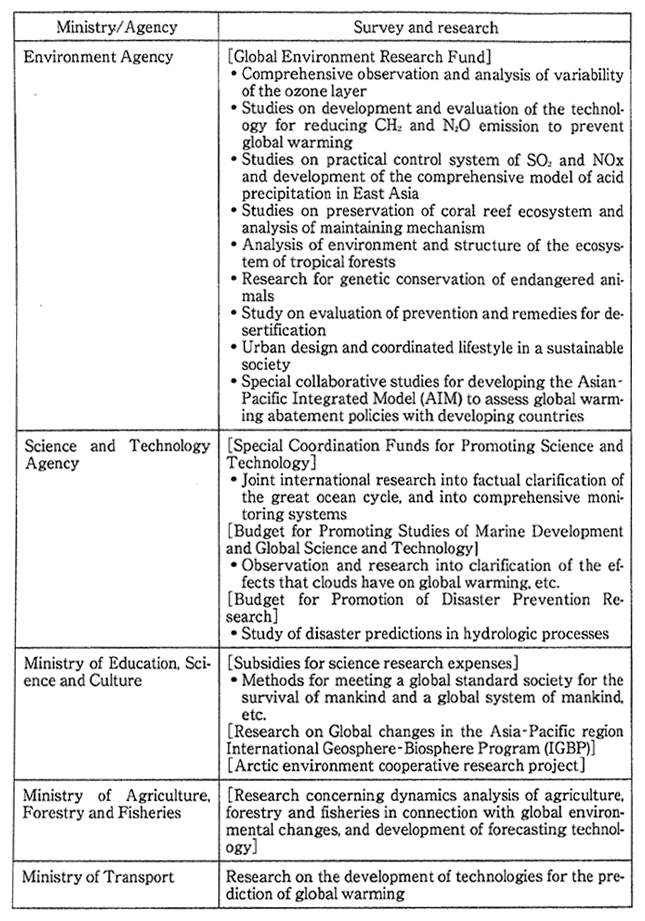
Table 8-5-2 Major Monitoring and Observation in the Global Environment Field in FY 1995
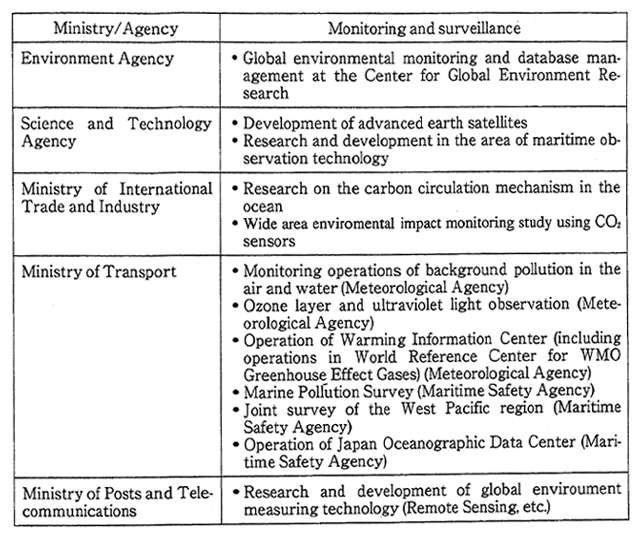
(5) Investigation for Promotion of the Basic Environment Plan
Investigation Costs for Promotion of the Basic Environment Plan is promotional survey costs calculated by the Environment Agency tar-gets surveys and research on topics positioned within the Basic Envi-ronment Plan, and can be classified into "policies" (surveys and re-search into policy proposals that are newly budgeted in FY1995, and which are implemented through the linked efforts of a number of minis-tries and agencies), and "emergencies" (surveys and research that were termed through FY 1994 as the Comprehensive Survey Promotion and Adjustment Budget for Environmental Conservation, and which are emergency responses to serious impacts on environmental conserva-tion).
The following six research themes were conducted in FY1995 under the "policy" category (total survey costs:175 million yen).
(i) Survey on the development of comprehensive indicators for the long-term objectives of the Basic Environment Plan
(ii) Survey and research into the effective linkage of energy policies taken for the prevention of global warming to housing and social infra-structure development
(iii) Survey and research into the promotion of reutilization and ra-tional use of containers and packages
(iv) Study and survey into the preservation of biological diversity through protection of habitat environments, and policies for their practi-cal application
(v) Survey into tasks on the Action Plan for Greening Government Operations
(vi) Study and survey into policies for achieving sustainable rural districts
In the "emergency" category, as well, surveys and research were conducted on 10 research themes, including a special research for temporarily Designated Endangered Species, an emergency study and research into cadmium safety, and a survey into the coexistence be-tween the kumagera (black woodpecker) and the forestry industry in the Shiragami mountain district (total survey costs :51 million yen).
(6) Other Experimental Research on Environmental Conservation
The Ministry of International Trade and Industry conducted studies on the capacity of marine organisms to absorb carbon dioxide, the ocean's carbon cycle mechanism, and wide-area environmental im-pact monitoring on the global distribution of carbon dioxide, and is also engaged in the research and development on technologies for the fixing, effective utilization, and disposal of greenhouse gases, alternative sub-stances for CFCs and HCFCs, and environment-friendly production technologies that emit less carbon dioxide or other substances that are burdens on the environment.
The Ministry of Transport conducted studies into water purifica-tion technologies for enclosed waters and canals where there is much demand for environmental improvement, and into technologies for the creation of high-quality sea area environments.
The Ministry of Construction conducted research and develop-ment of resource-and energy-saving national land construction technolo-gies, technologies to control the generation of construction byproducts, and technologies for effective disposal of bottom sediments of lakes and reservoirs.
The Ministry of Agriculture, Forestry and Fisheries conducted research and development into such areas as the agricultural systems that make advanced utilization of the material circulation capabilities of agricultural ecology systems, dynamics of greenhouse gases in agricul-tural, forestry and fishery ecologies and of their control technologies, ad-vanced disposal, reduction and value-adding technologies for livestock wastes, new weed-controlling technologies and technologies to reduce herbicide application, and comprehensive monitoring methods for envi-ronmental conservation in agricultural ecology systems.
The Ministry of Posts and Telecommunications conducted re-search and development into the global environment measurement and prediction technologies that utilize information telecommunication tech-nologies such as international joint research into advanced electromag-netic frequencies utilization technologies for use in studies on the mechanism of global environmental change, research into the global en-vironment measurement and prediction technologies through the use of high-resolution three-dimensional microwave imaging radar, and re-search into dual-frequency doppler radar for space-based monitoring of rainfall.
The Science and Technology Agency in cooperation with rele-vant institutions conducted research into remote sensing technologies for the global environment for the purpose of developing methods on satellite observations of the global environment and data processing, while the National Space Development Agency of Japan developed the Advanced Earth Observing Satellite (ADEOS), the Tropical Rainfall Monitoring Mission Satellite (TRMM), and the Advanced Earth Observ-ing Satellite II (ADEOS-IT), established in April 1995 the Earth Observa-tion Research Center which conducts research into the application of global monitoring information obtained from satellites in a wide range of other fields including Earth sciences technology research.
2. Promotion of Appropriate Technologies
It is necessary to promote technology development which can mitigate changes of the global environment not only for direct treat-ment of pollutants and other chemicals, but also for realization of sus-tainable development, including effective utilization of resources and en-ergy. Moreover, care must be taken to ensure that technology develop-ment for resolution of specific global environmental problems do, not cause other environmental problems, and it is also important to promote development of appropriate technologies for developing countries.
Working from this viewpoint, the Government has promoted technology development in such fields where international responses are required as global warming, depletion of the ozone layer, acid depo-sition, marine pollution, tropical deforestation and desertification, and has also enhanced and improved technology development structures. Major technology developments are shown in Table 8-5-3.
Table 8-5-3 Major Technology Development in the Global Environment Field Conducted in FY 1995
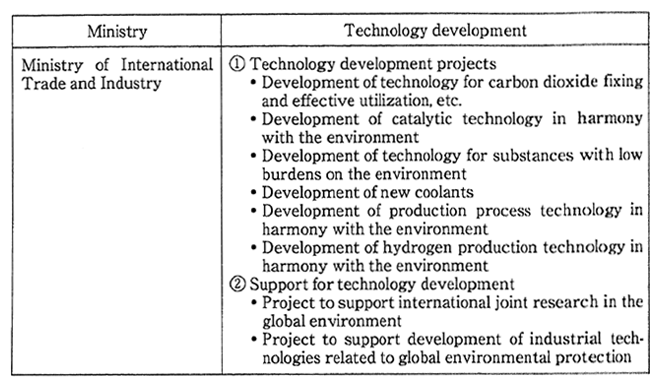
3. Preparing a Foundation by die National Government
A survey on unified quality control for environmental analytical measurement by the Environment Agency has been conducted since FY 1975 to improve and to promote all kinds of analytical measurement methods that are the base for environmental pollution monitoring and survey research.
At the first step of this survey, uniformly adjusted environ-mental materials are distributed to all participating laboratories in this survey.
Next, each laboratory analyzes the common samples and records their pre-treatment conditions, analytical apparatus and operating con-ditions during analysis.
After all of these records and the analytical results are reported to the Environment Agency, the Agency treats results and statistically analyzes the causes of dispersion of the analytical data. Finally, the En-vironment Agency and the participating analytical laboratories ex-change opinions and the Agency prepares a report on the results of the quality control analysis, including the opinions. This report is then dis-tributed to each participating laboratory and each government organ concerned.
Each participating laboratory can confirm and improve the qual-ity of its environmental analyses by referring to the report and to the discussion of the causes of data dispersion it contains.
In FY 1995, the surveys on six topics (cadmium, lead chrome, ar-senic, zinc and manganese) in the soil sample of the plant site and on three topics (tetrachloroethylene, dichloroethylene and cymazine) in the simulated wastewater sample were conducted.
Based on the "Industrial Standardization Law," the Ministry of International Trade and Industry expanded Japanese Industrial Stan-dards in FY 1995 for methods for pollutant analysis and for automated measuring instruments, and also conducted basic research into the stan-dard materials that form the foundation for these standards.
The Ministry of Education, Science, Sports and Culture promotes wide-ranging basic research related to environmental conservation that is conducted by university researchers, and also trains researchers in the field of environmental conservation.
In addition, Grant-in-Aid for Scientific Research on Priority Ar-eas included the establishment of such priority areas as "A Scientific Approach Toward Globalized Human Society in Harmony with the Earth Man-Earth Systems," and promotion of basic research on the en-vironment. This research was also promoted in ordinary research cate-gories at Grant-in-Aid for Scientific Research, as well.
4. Promotion of Efforts in Local Public Authorities and Private Groups
Environment-related experimental research institutions in local public authorities play wide-ranging roles in scientifically backing envi-ronmental administration, including the conduct of monitoring and measurement, analysis, surveys, and collection of basic data, and ac-tively promote research activities on environmental problems specific to their own regions.
The Environment Agency maintains close links with these local environment-related experimental research institutions and, as part of efforts for more effective promotion of research, hosted a meeting of the heads of local experimental pollution research institutions and others in FY 1995. In the same year, a Meeting for Reports on Environmental Conservation and Pollution Control Research was held in Yokohama as a forum for announcing the results of the latest surveys and research conducted at local environment-related experimental research institu-tions, and was used for promoting information exchanges between re-searchers. In addition, the National Institute for Environmental Studies carried out joint research on 42 subjects with 26 local environmental re-search institutions in FY 1995.
The Measurement Law stipulates the specific meter devices that may be applied as such pollution measurement devices as noise meters, density meters, and vibration level meters, and manufacturers are re-quired to provide project application and project report forms (via the prefectural governor). Based on this information, the prefectures use on-site inspections to assure the appropriate use of measuring devices.
The Japan Quality Assurance Organization issues certification publicly securing accuracy for some pollution measurement devices.
The Chemicals Inspection & Testing Institute, Japan is commis-sioned by the Government to conduct research and development into low-density standard substances, and uses the standard measured sup-ply accuracy to ensure smooth flows of high-precision standard sub-stances to industry.
Measurers employed for measuring proof related to the environ-ment are licensed according to the knowledge and experience required for appropriate inspection of measuring instruments and for other measuring controls.
5. Dissemination of Research Results
The Environment Agency uses the mass media to widely an-nounce research results conducted at the National Institute of Environ-mental Studies, or at national institutes of experimental research fund-ing for pollution control, and uses meetings for reports on environ-mental conservation research, collections of environmental conservation research result, and other forums for disseminating or introducing re-suits to private corporations.
And for global environmental research, the agency selects spe-cific research fields for hosting symposiums with the broad participa-tion of the most advanced researchers in Japan and abroad.
Section 6. Development and Provision of Environmental Information
1. Systematic Development of Environmental Information (Collection, Arrangement, Processing)
For information on environmental information sources, the Envi-ronment Agency conducted a survey of the state of development of en-vironmental information, and further expanded its Guide to Environ-mental Information Sources (El-Guide), which points out where environ-mental information is located, and contains its summary.
And for databases on the global environment, the Agency strengthened its collection of various kinds of information on the global environment, promoted integration of global environmental research and expanded global environmental monitoring activities, and then ar-ranged the results. In addition, the National Institute of Environmental Studies (NIES) filled out and strengthened its role as a cooperative cen-ter for the Global Resource Information Database (GRID) of the United Nations Environment Programme (UNEP).
For bio diversity information, the Agency strengthened an infor-mation source system for survey reports, maps, specimens and other in-formation and initiated a design of an information system for the species listed in the Red Data Book.
Moreover, the Agency collected and analyzed information on trends in the environmental burden of daily life, an area that accounts for a large portion of the burden by volume on the environment and. yet is an area where enough information is not available.
2. Providing Environmental Information to the People
Building on systematic collection, arrangement, and processing of environmental information, the Environment Agency developed the "Environmental Information and Communication Network System," al-lowing anyone around the country to be able to access information con-cerning the Government's environmental conservation policies, etc., and commenced its operations in March 1996. The Agency also provides en-vironmental information through many other medial including publica-tions beginning with this annual report on the environment "White Pa-per on the environment" and magnetic media recording environmental monitoring data. The Agency has worked intensively at making the "White Paper on the Environment," available in many forms, including the English version, chart-and-graph version, cartoon version and calen-dar version. Video presentations and musical scenarios were also pro-duced.
In addition, natural park visitor centers or world heritage centers were developed as environmental information centers, and studies were conducted on development of such sites as environmental conservation activity centers, biodiversity centers, and other relevant centers.
3. Environmental Information Infrastructure
The Environment Agency prepared hardware and software for the local network that is required for construction of an environmental information system, conducted training for its use, and performed proper system operations.
4. Support for Development of Environmental Information in Local Governments and Private Groups
The Environment Agency included provision of environmental resource information as one of its information system development menus to provide financial support to the initiatives being taken in cities, towns and villages.
In addition, to support private sector's environmental conserva-tion activities, the Agency commenced development of a database for relevant groups and their activities.
Section 7. The Regional Environmental Pollution Control Programs
1. Formulation of the Programs
(1) Formulation of the Regional Environmental Pollution Control Programs
The Regional Environmental Pollution Control Programs are re-gional programs formulated for the purpose of preventing pollution in the specific areas based on Article 17 of the Basic Environment Law. The programs are formulated for the purpose of preventing pollution in areas proven to be extremely difficult to do so because of their marked pollution, unless some comprehensive action is taken. The fundamental policies of the programs are now being formulated based on the Basic Environment Plan, following its adoption.
Most major industrial cities and metropolitan areas around Japan formulated Regional Environmental Pollution Control Programs in the period between December 1970 and January 1977. Some of the pro-grams whose terms expired after 1977 have been reviewed due to im-provement of the environment, and plans are being formulated in 34 ar-eas around Japan (Table 8-7-1 and Chart 8-7-1).
(2) Summary of the Regional Environmental Pollution Control Programs Areas
Districts in which the Regional Environmental Pollution Control Programs have been formulated cover the nation's major industrial ur-ban areas and metropolitan areas. The percentage of Regional Environ-mental Pollution Control Programs areas nationwide is about 9% in area, 55% in population, and about 60% in amount of outgoing shipment of merchandise.
(3) Districts formulating Regional Environmental Pollution Control Programs in FY 1995
A. Directives and Approvals for Districts Formulating Regional Environmental Pollution Control Programs in FY 1995
On 22 September 1995, the Prime Minister declared that formula-tion of new Regional Environmental Pollution Control Programs was necessary for six districts, including the Tiachinohe district, whose plans had expired by the end of FY 1994, and, revealing the fundamental pol-icy for Regional Environmental Pollution Control Programs to be formu-lated based on the Basic Environment Plan, directed the relevant pre-fectural governors to formulate pollution control plans.
Table 8-7-1 Formulation of Regional Environmental Pollution Control Programs
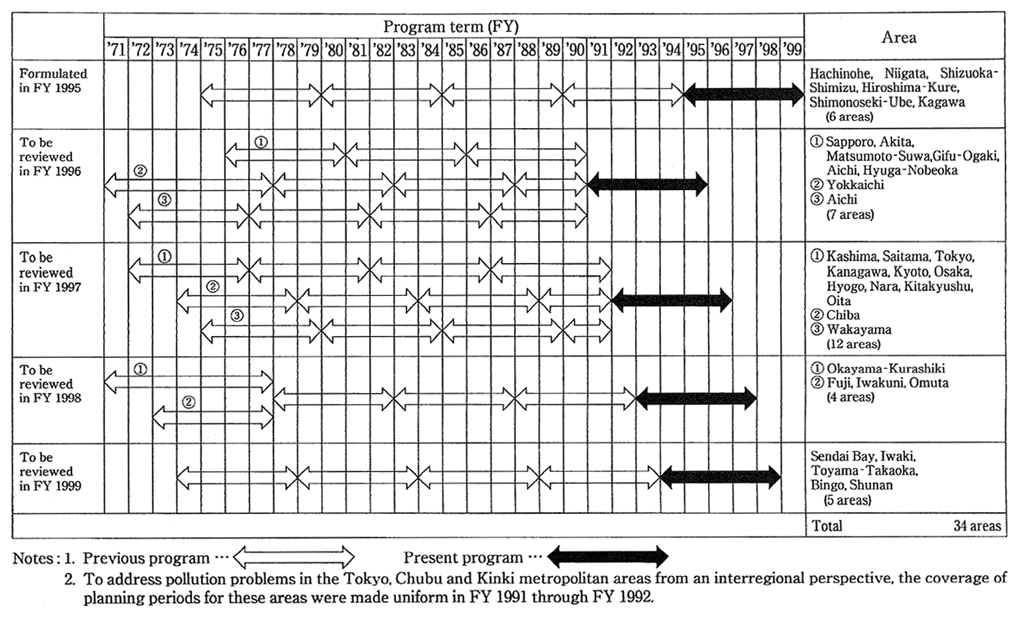
Fig. 8-7-1 Areas with Regional Environmental Pollution Control Programs Formulated (Present Programs)
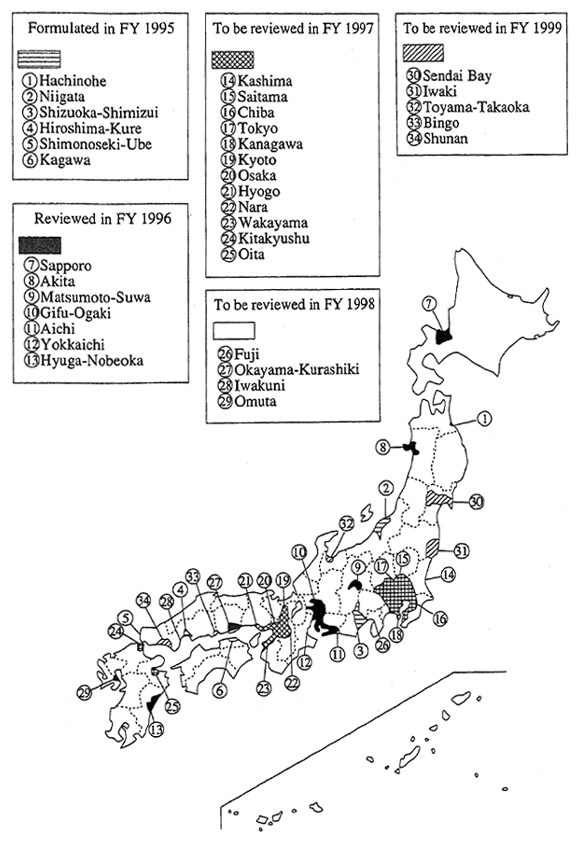
Source: Environment Agency
The prefectural governors who were directed to adopt plans in FY1995 drew up pollution control plans based on policies relevant to each district, and received approval on 15 February 1996 from the Prime Minister for each Regional Environmental Pollution Control Pro-gram.
B. Summary of Regional Environmental Pollution Control Programs in FY 1995
The summary of Regional Environmental Pollution Control Pro-grams in FY 1995 is as follows.
Table 8-7-2 Areas with Regional Environmental Pollution Control Programs
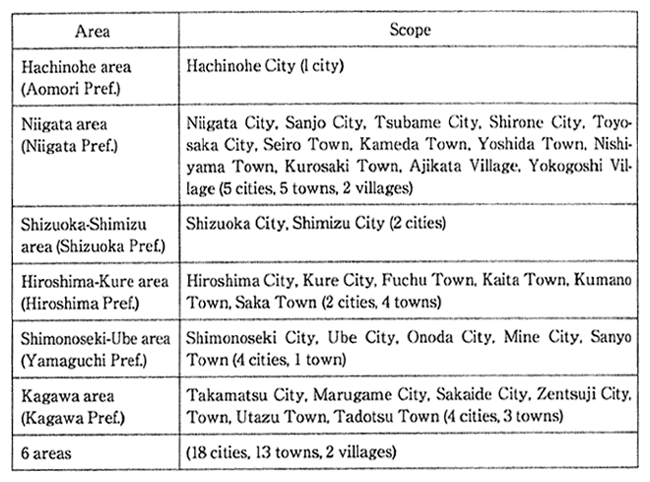
(A) Extent of Districts
The extent of these six districts is shown in Table 8-7-2.
(B) Targets of Programs
The targets of these plans are environmental quality standards for air pollution, water pollution, noise pollution, soil pollution, etc., with the main part of the plan making reference to achievement of the long-term objectives for pollution control stipulated in the Basic Environ-ment Plan, and using the promotion of various pollution control policies to strive for achievement of general goals set for the term of the plan.
(C) Term of Programs
The term of these programs is five years, from FY 1995 to FY 1999.
(D) Measures for Regional Environmental Pollution Control Programs
Enterprises are to take measures for preventing air pollution and water pollution whereas local public entities are to comprehensively promote the plan through adoption of such policies as regulations for ex-hausting pollution sources, environmental impact assessments, guid-ance on location, justification of land use, and measures against small-and medium-scale businesses, and by engaging in such pollution coun-termeasure projects as development of sewers, maintenance of buffer green zones, maintenance of waste disposal facilities, maintenance of school environments, dredging and water conveyance, land improve-ments for pollution countermeasures, and maintenance of a surveillance measurement, as well as by engaging in such pollution-related projects as park and green land development, traffic measures and ground sub-sidence measures.
In particular, for those priority actions specifically identified in the fundamental policies as areas of special importance to each district, the policies are being filled out and strengthened through the establish-ment of numerical goals where necessary for developing standards and for other policies related to pollution countermeasure projects, and through the adoption of attainable policies that incorporate the intro-duction of new aspects.
Moreover, in the course of formulating the Regional Environ-mental Pollution Control Programs, implementation of the main part of the plan must take into consideration the achievement of long-term ob-jectives stipulated in the Basic Environment Plan.
(E) Financial Measures
The necessary costs for these districts of the implementation of policies to prevent pollution during the term of the plan is estimated to be 77.2 billion yen for measures to be adopted by businesses, 1,096.9 bil-lion yen for pollution countermeasure projects under the policies to be adopted by local public entities and others, and 521.4 billion yen for pollution-related projects.
2. Promotion of the Implementation of Regional Environmental Pollution Control Programs
(1) Implementation of Regional Environmental Pollution Control Program Projects
Local public entities and others are adopting comprehensive poli-cies for control of pollution, based on the Regional Environmental Pollu-tion Control Programs. Their state of implementation is shown in Table 8-7-3, with project costs for pollution control projects totaling 2.5364 tril-lion yen in FY 1995, and project costs for pollution-related projects total-ing 1.0749 trillion yen, for a grand total of 3.6113 trillion yen.
(2) Special Financial Measures Taken for Regional Environmental Pollution Control Programs
To further promote pollution measures, special measures for na-tional financing of pollution control countermeasure projects that have been implemented by local public entities and others based on the Re-gional Environmental Pollution Control Programs have been adopted in accordance with the "Law Concerning Special Financial Measures for Environmental Pollution Control Projects" (hereafter referred to as the "Law")1 including a higher ratio of subsidies and assistance by the na-tional government, expanded local debt in the form of bond issues to fi-nance projects, and inclusion of the value of demand for standard financ-ing in the principal and interest redemption value of local bonds issues.
Table 8-7-3 Implementation of Regional Environmental Pollution Control Program
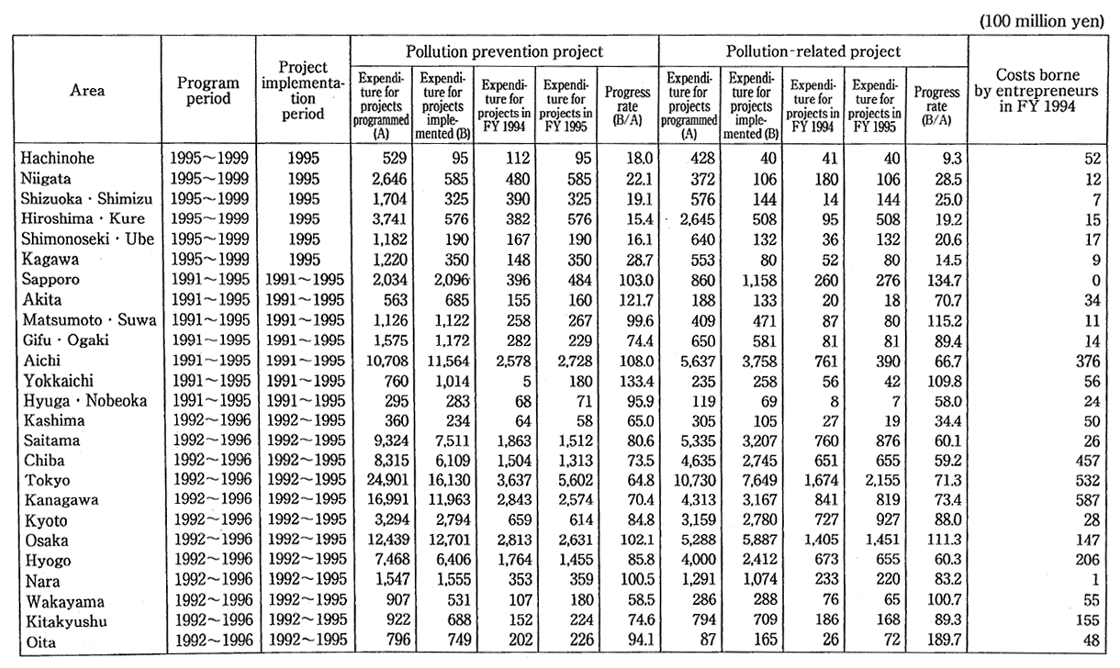
(Table 8-7-3 contd.)

Notes 1. Pollution countermeasure projects refer to projects undertaken to prevent pollution and include the maintenance of sewerage facili-ties, green buffer zones, waste disposal facilities, school grounds, drainage facilities, irrigation systems, land reforms, monitoring and measurement systems, and others.
2. Pollution prevention-related projects refer to projects undertaken in relation to pollution prevention, including the maintenance of parks and greenery. traffic countermeasures, and land subsidence-related countermeasures.
3. Figures for FY 1994 are final, and those for FY 1995 are estimates. *The project expenditure in FY 1995 for areas in which the pro-gram has been established in FY 1995 is the project expenditure indicated in the previous program which had been completed.
4. Figures for each area may not equal totals, as figures are rounded.
Table 8-7-4 shows the project costs for pollution control counter-measure projects over the past five years, alongside the amount of cov-erage offered by national government subsidies and assistance. The amount of coverage in FY 1995 was 44.9 billion yen.
Table 8-7-4 Project Expenditure and Amount of Increase in the Government's Share or Subsidies for Public Pollution Control Projects
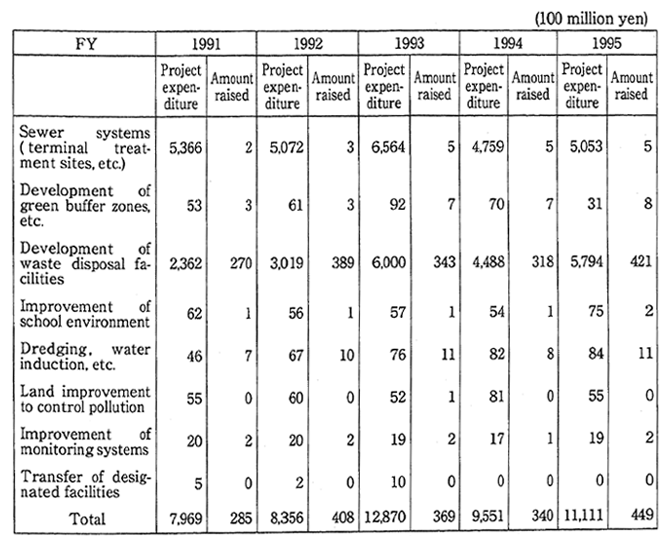
Note : The amounts of the project expenditures and amounts raised were those pro-jected for FY 1995
Source: Environment Agency
(3) Environmental Quality in Areas with Regional Environmental Pollution Control Programs
With the promotion of various policies based on Regional Envi-ronmental Pollution Control Programs, the conditions of major pollut-ants in districts formulating Regional Environmental Pollution Control Programs are as follows.
For sulfur dioxide, the percentage of monitoring stations that passed long-term environmental quality standards (number of monitor-ing stations met with standard/number of valid monitoring sttations) was 100% in FY 1994.
For nitrogen dioxide, the conditions of response to environmental quality standards are shown in Table 8-7-5. with the percentage of moni-toring stations that exceeded the upper environmental standard limit of 0.6 ppm in FY 1994 being 7.5%.
Table 8-7-5 Compliance with Environmental Quality Standards for Nitrogen Dioxide in Regional Environmental Pollution Control Programs Areas
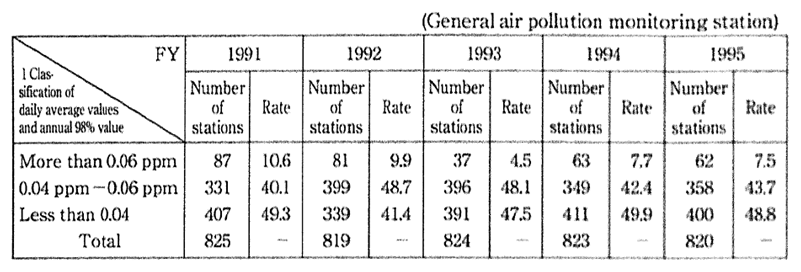
Notes : 1.Monitoring Stations which have not completed the valid monitoring hours are excluded
2. Zaltman's Coefficient= 0.84
Source: Environment Agency
For suspended particulate matter, the conditions of conformance to long-term environmental quality standards are shown in Table 8-7-6. with the percentage of passing station being 43.6% in FY 1994. J
Table 8-7-6 Compliance with Environmental Quality Standards for Sus-pended Particulate Matters in Regional Environmental Pollu-tion Control Program Areas

Note : The monitoring stations which have not completed the valid monitoring hours are excluded.
Source : Environment Agency
For photochemical oxidants, one station out of 678 monitoring stations passed the environmental standard (a one-hour value of 0.06 ppm or less) in FY 1994.
For water quality in rivers, lakes and sea areas, the conditions of conformance to BOD or COD environmental quality standards (number of water areas met with standard/total number of water areas) may be seen in Table 8-7-7, with the conformance rates in FY1994 being 58.4% for rivers (BOD), 4.3% for lakes (COD) and 72.2% for sea areas (COD).
Table 8-7-7 Compliance with Environmental Quality Standards for Rivers, Lakes and Reservoirs and Sea Areas in Regional Environ-mental Pollution Control Program Areas
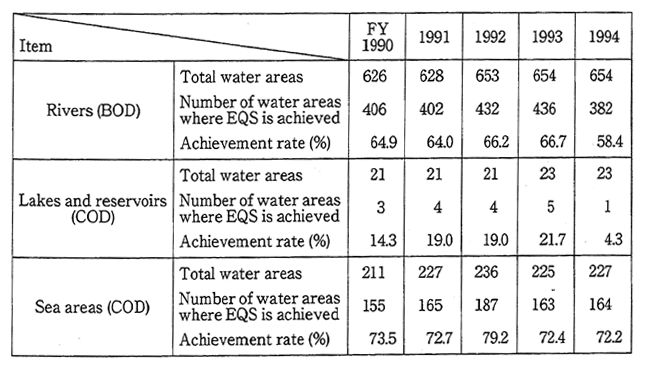
(4) Implementation of Pollution Control Countermeasure Projects Designated by the Minister of Home Affairs
Of the pollution control countermeasure projects that were im-plemented by local public entities in areas other than districts that for-mulated Regional Environmental Pollution Control Programs, some were designated by the Minister of Home Affairs, in cooperation with the responsible minister and with the Director-General of the Environ-ment Agency, as special projects. Article 3, Section 3, of the Special Law for Pollution Control Financing stipulates that these projects must be treated as special measures under the same public financing rules used for the pollution control countermeasure projects, based on pollution control plans. Pollution control countermeasure projects so designated over the past five years shown in Table 8-7-8
Table 8-7-8 Pollution Prevention Projects Designated by the Minister of Home Affairs
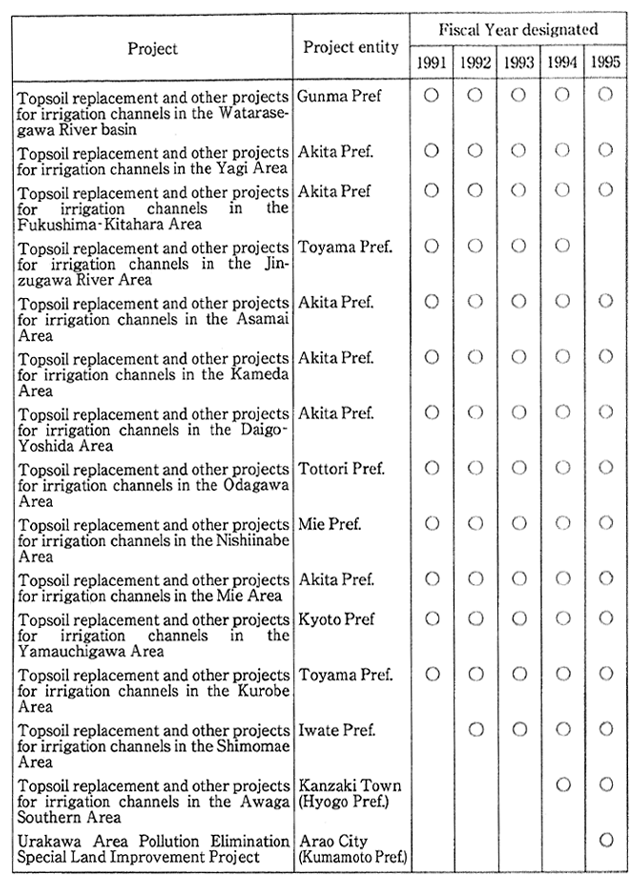
Note: By FY 1990,49 projects had been completed.
Section 8. Environmental Health Measures, Settlement of Pollution Disputes, etc.
1. Relief for and Prevention of Health Damage
(1) Compensation and Prevention of Pollution-related Health Damage, etc.
A. Summary of the Compensation and Prevention System for Pollution-related Health Damage
The Pollution-Related Health Damage Compensation Law went into effect on 1 September 1974 for the purpose of offering timely and fair protect ion for victims of pollution-related damage to health, and it has played a major role in the protection of victims of such health dam-age.
This system operates through the civil damage compensation system to require the owner of the source of pollution to bear the ex-pense of compensation for health victims. Diseases targeted by the sys-tem consist of two types, one that includes bronchial asthma and similar diseases where no one-to-one relationship can be established between the disease and a particular substance (districts with severe air pollu-tion that result in widespread outbreaks of bronchial asthma and similar diseases arc designated as Class I areas), and one that includes Mi-namata disease, Itai-itai disease (cadmium poisoning), chronic arsenic poisoning and other similar diseases where a one-to-one relationship can be established between the disease and a particular substance (areas with severe environmental pollution that result in widespread out-breaks of such specific ailments are designated as Class II areas).
Class I areas were subjected to a review in response to the changes in the condition of air pollution, and the Central Council for En-vironmental Pollution Control issued a report in October 1986 titled Or the Handling of Class I areas under the Pollution-Related Health Dam age Compensation Law. Based on this report, the system was changed including; (i) abolition of the Class I area designation, (ii) continuation of compensation and benefits for already certified victims, (iii) imple mentation of projects to prevent health damage due to the effects of air pollution, and (iv) changing of the name of the law to the "Law Concern ing Compensation and Prevention of Pollution-related Health Damage." All of these measures were passed into law in March 1988.
The current state of air pollution suggests no change in the sys-tem's revision and rationalization based on the scientific evaluation that air pollution cannot be considered to be the main cause of bronchial asthma and similar diseases, and the current policy of protecting al-ready certified victims and of working to prevent further health dam-age will continue to be implemented.
It is important to note that a Law Partially Revising the Law Concerning Compensation and Prevention of Pollution-related Health Damage was passed in March 1995, containing; (i) revised conditions for provision of survivors' compensation, and (ii) creation of special treatment for renewals of approval in case of disasters, etc.
B. Air Pollution-related Diseases
(A) Compensation, etc., for Already Certified Victims
There were 75,150 already certified victims as of the end of De-cember 1995, with no new victims being designated after the Class I area designation was abolished on 1 March 1988 (Table 8-8-1). These al-ready certified victims may receive compensation, i.e. (i) medical ex-penses, (ii) disability compensation, (iii) survivors' compensation, (iv) lump-sum survivors' compensation, (v) children's compensation allow-ance, (vi) medical allowance, and (vii) funeral costs, based on the Law Concerning Compensation and Prevention of Pollution-related Health Damage (hereafter referred to as the "Compensation Law"), and have their approvals renewed.. In addition, pollution-related health and wel-fare projects, i.e. (i) rehabilitation projects, (ii) sanatorium convalescent care projects, (iii) medical device supply projects for home-based medi-cal care, and (iv) guidance projects for home-based medical care, are also being conducted to support the welfare of these already certified vic-tims.
The costs incurred for compensation are divided into those in-curred by fixed sources of pollutants such as facilities generating smoke and soot, and those incurred by automobiles, with the ratio being ap-proximately eight to two.
The Pollution-related Health Damage Compensation Grievance Board was established to investigate claims made in relation to the dis-posal of certification or of provision of compensation. A total of 199 claims investigated as of the end of December 1995 were related to Class I areas, with 18 claims canceled, 14 claims dismissed, 127 claims rejected, and a further 35 claims withdrawn.
Table 8-8-1 Designated Areas, Number of Certified Patients and Other Matters under the Law Concerning Compensation and Preven-tion of Pollution-related Health Damage
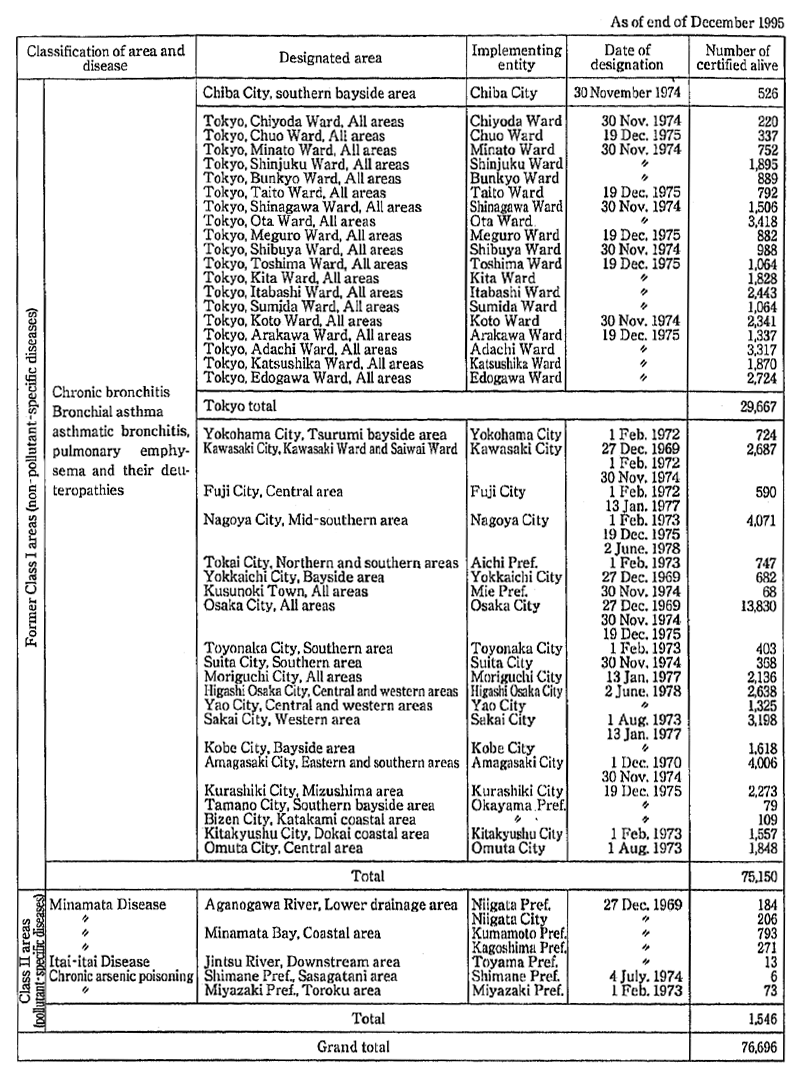
Note: The identification of former designated areas is all according to the demarcations in force at the time of designation.
Source: Environment Agency
(B) Implementation of the Health Damage Prevention Projects
With implementation of the revised law in March 1988, a project for the prevention of new health damage arising from the effects of air pollution (hereafter referred to as the Health Damage Prevention Pro-ject) was instituted. This project supplements earlier policies conducted by the national government and local public entities to prevent health damage due to air pollution, and makes them more effective. The pro-ject content includes activities directly under the Preventive Associa-tion for Pollution-related Health Damage Compensation (hereafter re-ferred to as "the Association"), including (i) surveys and research, (ii) knowledge dissemination and (iii) training, and activities conducted by local public entities and environmental corporations, with the assistance of the Association, that target the former Class I areas, including (i) preparation of plans, (ii) health consulting, (iii) health diagnoses, (iv) func-tional training, (v) facilities development, and (vi) assistance for facilities development (Fig. 8-8-1).
Financing for this project is generated from the operating profits of funds in the Association. The total amount of the funds is about 50 bil-lion yen, and the funds had accumulated annually through donations from owners of direct sources of air pollution, from people conducting business activities related to air pollution, and from national govern-ment outlays. Fund accumulation was completed at the end of FY 1994.
The state of the Health Damage Prevention Project in FY 1995 was as follows.
(i) Projects conducted directly by the Association
Surveys and research include integrated research into the health effects of air pollution and surveys to obtain materials for improving the air environment, while knowledge dissemination takes such forms as the asthmatic child swimming festivals, low-pollution vehicle fairs, cam-paigns such as the Month for the Promotion of Air Pollution Prevention, and preparation of pamphlets for the prevention and recovery of asthma. Training is also being conducted for Health Damage Prevention Project personnel.
Moreover, a project to provide knowledge and information ob-tained from the Health Damage Prevention Project was launched in the current fiscal year.
Fig. 8-8-1 Outline of Health Damage Prevention Projects
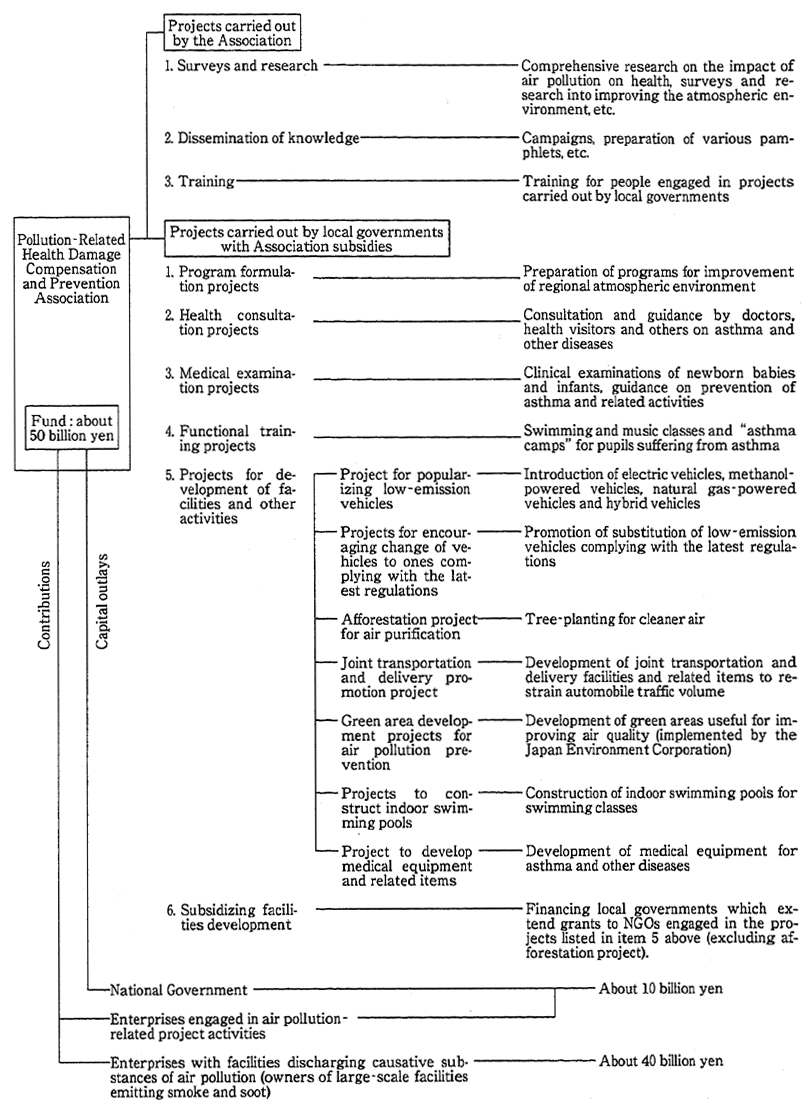
(ii) Grant Subsidized by the Pollution-related Health Damage Compensation and Prevention Association
Subsidies were granted to 57 local public entities and environ-mental corporations, which were used to target the former Class I areas and other areas with the preparation of plans for the improvement of air pollution conditions, health consultations for asthma and other ill-nesses, health examinations for infants and children, functional training for asthma camps and similar activities, introduction of electric vehicles and other low-pollution vehicles, air purification through planting of trees, development of green belts as a countermeasure against air pollu-tion, and so on.
C. Minamata Disease
(A) Compensation for Certified Victims
a. Certification procedures for Minamata disease
Minamata disease is an ailment of the central nervous system which afflicts those who consume fish or shellfish that are contaminated with methyl mercury. The outbreaks were first discovered in and around Minamata Bay in Kumamoto Prefecture in May 1956 and then in the Aganogawa river drainage system in Niigata Prefecture in May 1965, and were caused, according to the unanimous view of the Govern-ment as announced in 1968, by discharges of methyl mercury from. the plants owned by Chisso Corporation and Showa Denko, K.K., respec-tively.
Kumamoto Prefecture, Niigata Prefecture, and other local public entities independently responded to the outbreaks with their own Mi-namata disease measures. The "Law Concerning Special Measures for Relief of Pollution-related Health Damage" (hereafter referred to as "Re-lief Law"), however, promulgated in December 1969, placed official des-ignations on each of the affected districts and gave legal certification to the victims. In September 1974, the "Relief Law" was followed by the "Compensation Law" and its district designations, and certification pro-cedures continued. With the sudden increase in applicants from Ku-mamoto Prefecture for certification as sufferers of Minamata disease, the progress of certification procedures became an urgent issue, result-ing in the report entitled "Promotion of Minamata Disease Measure," given at the meeting of relevant Cabinet ministers on Minamata disease in June 1977. In response to this, a notification entitled "Criteria for Dif-ferentiation of Acquired MinamataDisease" was issued by the Director of the Division of Environmental Heal h in July 1977, specifying and clarifying the medical diagnostic protocols for certifying Minamata dis-ease. In Kumamoto Prefecture, as well as, certification procedures ad-vanced with the development of diagnostic and investigative systems. Furthermore, the "Temporary Measures Law Concerning Promotion of Certification Procedures for Minamata Disease" was passed in Febru-ary 1979, and the National Government also commenced certification procedures.
Certification of Minamata disease has been bas d on medical de-terminations from the beginning, with an October 1985 medical ex-perts' conference on Minamata disease confirming the reasonableness of conditions for determining Minaniata disease that had previously been set in July 1977. And again, the report by the Central Council for Environmental Pollution Control en titled "Future Measures to Cope with Minamata Disease," issued in November 199 1,, did not present any knowledge that would make it necessary to change the determined con-ditions.
The number of certified victims as of the end of December 1995 was 2,950 people (1,773 people in Kuniamoto Prefecture, 487 people in Kagoshima Prefecture, and 690) people in Niigata Prefecture). Of these, the number of these victims still surviving was 1,454 people (793 people in Kumamoto Prefecture, 271 people in Kagoshima Prefecture, and 390 people in Niigata Prefecture).
b. Conclusion of the Compensation Agreement
The court decision on the First-stage Minamata Disease (Niigata) Civil Suit was handed down in September 1971, while the decision on the First-Stage Minamata Disase (Kunmmoto) Civil Suit appeared in March 1973, with liability for damage compensation confirmed to rest on Showa Denko, K.K. and Chisso Corporation, respectively. The asso-ciations of the victims and the polluting corporations were able to reach agreements on compensation through dir Ct negotiation based on those decisions. The certified victims began receiving direct compensation from the polluting corporations from that time, based on the agreement, and the problem of compensation for the certified victims was thus re-solved.
c. Financial Support to Chisso Corporation
Based on the compensation agreement, Chisso Corporation, the polluter, has been providing compensation for certified victims in Ku-mamoto and Kagoshima Prefectures. To ensure, however, that no hin. drances to the continued payment of compensation would arise, and to provide stability to the regional economy and society, while firmly main-taining the principle that the pollution source must bear the burden, Ku-mamoto Prefecture took the step in 1978 of issuing a prefectural bond to obtain working capital, with the consent of the Cabinet, and offered a loan to Chisso Corporation.
Moreover, as a medium- to long-term support policy for Chisso Corporation, Kumamoto Prefecture issued a prefectural bond in 1994, with the consent of the Cabinet, for the purpose of providing plant and equipment investment capital for Chisso Corporation's Minamata Plant, using the Minamata-Ashikita Regional Promotion Fund to funnel the procured working capital in the form of a loan to Chisso Corporation.
(B) Measures Taken toward Rejected Certification Applicants
a. The Minamata Disease Comprehensive Countermeasures Medical Project
The Environment Agency, concerned about the existence of health problems among residents of regions with outbreaks of Mi-namata disease, particularly among those people whose applications for certification were rejected, which was resulting in a major social prob-lem, asked the Central Council for Environmental Pollution Control in November 1991 to conduct an inquiry into what sort of comprehensive countermeasures might be needed for this problem.. The council re-sponded the same month with the report entitled "Future Measures to Cope with Minamata Disease."
Based on this report, the agency instituted from June 1992 the Health Management Project for conducting health examinations of peo-ple who may have been exposed to more than the conventional level of methyl mercury sometime in the past, and the Minamata Disease Com-prehensive Countermeasures Medical Project, which incorporates within it the Medical Project that provides medical expenses and medi-cal allowances for people with sensory impairments in. the four-limb ex-tremities which are apparently due to Minamata disease. The period of application for the Medical Project lasted until the end of March 1995. However, those people whose applications for certification were under consideration based on the "Compensation Law" and were only re-jected after the end of March 1995 were allowed to make applications for the Medical Project within six months of certification rejection, and the period of application for the project was extended to 21 January 1996. Of the applications received by 21 January 1996, 4,790 applicants (3,538 people in Kumamoto Prefecture, 937 people in Kagoshima Prefec-ture, and 315 people in Niigata Prefecture) became target recipients of the Medical Project.
b. Administrative Grievance Inspection Claims, Civil Suits, etc.
Although the national and prefectural governments adopted such policies as certification of Minamata disease in accordance with the "Compensation Law" and other laws, and implementation of the Mi-namata Disease Comprehensive Countermeasures Medical Project, etc., people dissatisfied with having their certification applications rejected filed administrative grievance inspection claims or administrative civil suits, while other people, mainly those whose certifications were re-jected under the "Compensation Law," sought relief by filing civil suits for damage compensation claims, or by conducting independent nego-tiations, and these cases remained unresolved.
(a) Administrative grievance inspection claims in response to rejec-tion of certification applications
The number of administrative grievance inspection claims filed with the Director-General of the Environment Agency concerning treatment under the "Relief Law" totaled 635 claims by the end of De-cember 1995, of which 13 claims were canceled, two claims were dis-missed, 462 claims were rejected, and a further 37 claims were with-drawn. The number of inspection claims filed with the Pollution-Related Health Damage Compensation Grievance Board concerning treatment under the "Compensation Law" totaled 677 claims by the end of Decem-ber 1995, of which six claims were canceled, two claims were dismissed, 257 claims were rejected, and a further 65 claims were withdrawn.
(b) Minamata disease-related civil suits In May 1980, plaintiffs (most of them are people whose certification ap-plications had been rejected) filed a civil suit for the first time, in Ku-mamoto District Court, against both the corporations and the national and prefectural governments seeking an assessment of responsibility for allowing the outbreak of Minamata disease to spread, and also seek-ing relief for victims. Similar suits were then filed at later dates in To-kyo, Niigata, Kyoto, Osaka and Fukuoka
To date, six district court decisions have been handed down on the above civil suits. In three of these district court decisions, including the Tokyo District Court decision of February 1992, the Niigata District Court decision in March of that same year, and the Osaka District Court decision in July 1994, the national and prefectural governments were not found to have any liability, and liability for damage compensation was restricted to the corporations alone. On the other side, three dis-trict court decisions, including the Kumamoto District Court in March 1987 and again in March 1993, and the Kyoto District Court in Novem-ber of that same year, found both the corporations and the national and prefectural governments to have liability for damage compensation, All of these rulings were appealed to higher courts.
Moreover, six courts since September 1990 have recommended compromise settlements. The national government has responded, how-ever, that it cannot respond to these recommendations for compromise settlement because the nature of the problems at the center of the civil suits does not permit a compromise with regard to the basic position of the national government.
In addition, administrative incident civil suits (appeal suits) were also lodged seeking cancellation of the rejections of applications of pre-fectural governors for Minamata disease certification.
c. The Final and Complete Solution to the Minamata Disease Problem
As can be seen from the above, efforts were being made toward a political solution to those related problems of Minamata disease which remained unresolved and a policy for a final solution was drawn up in September 1995 toward achievement of a final and complete solution, Based on this policy, all concerned parties reached an agreement by De-cember 1995 for a resolution to the problem.
A summary of this agreement includes, for various disputes about Minamata disease, lump-sum payments by the corporations to alt those people seeking relief who are currently targeted by the Compre-hensive Countermeasures Medical Project, or who are surviving family members of the people targeted by the project who have already died, and to those people who became targeted by the Comprehensive Coun-termeasures Medical Project after applications were reopened or to the survivors of the people who have died and were judged to be equivalent to those who were targeted ; expressions of regret by the national and prefectural governments and statements showing some sort of attitude of responsibility; the termination of civil suits and other disputes by the people receiving relief to ensure an early date for a final and complete solution ; and, in response to this termination of disputes, the continu-ation and reopening of applications for the Comprehensive Countermea-sures Medical Project by the national and prefectural governments, and the conduct of the policies to support Chisso Corporation and to rede-velop and promote the local economy. Based on this agreement among the various parties, the national government convened a Cabinet meet-ing for ministers concerned with Minamata disease on 15 December 1995 for the purpose of swift adoption of measures for a final and com-plete solution to the Minamata disease problem, and released the report entitled "Minamata Disease Policy." On that same day, the Cabinet min-isters approved the content of the report, and the Cabinet also approved some message by the Prime Minister on the solution to the Minamata disease problem.
Minamata Disease Policy
Cabinet approval on 15 December 1995
Concerning the Minamata disease problem the various par-ties have reached an agreement to achieve a solution to the prob-lem, through the appended agreement items (omitted). Based on the said agreement, the national government shall swiftly adopt the following measures to achieve a final and complete solution to the Minamata disease problem.
I. Reopening of acceptance of applications for the Minamata Disease Comprehensive Countermeasures Medical Project
The national government shall adopt the necessary meas-ures so that Kumamoto Prefecture, Kagoshima Prefecture and Nii-gata Prefecture can swiftly reopen acceptance ~f the applications for the Minamata Disease Comprehensive Countermeasures Medi-cal Project.
II. Support measures for Chisso Corporation related to lumpsum payments, as well as other regional redevelopment and promotion policies, etc.
1. Support measures, etc., for Chisso Corporation related to lump-sum payments
(1) Concerning the redevelopment and promotion of the Minamata-Ashikita region, the national government shall, when Kumamoto Prefecture establishes a fund (hereafter referred to as "the Fund") as a loan project for providing loans related to lump-sum payments by Chisso Corporation for the purpose of a final and complete solution to the Minamata disease problem, swiftly adopt the necessary public finance measures and local public finance measures to provide capital for Kumamoto Prefecture related to the said project. When Kumamoto Prefecture issues local bonds for the purpose of capitalizing the Fund, the capital operations depart-ment shall assume the entire capital amount.
(2) While firmly maintaining the principle that the polluter bears the burden, the national government shall maintain and strengthen the business operations foundation of Chisso Corpora-tion to ensure that no hindrances to the payment of the compensa-tion to the victims appear, shall swiftly conduct in the relevant min-istries and agencies studies of the business situation of the com-pany to ensure regional economic and social stability, and shall take appropriate actions at appropriate times.
2. Other regional redevelopment and promotion policies
(1) When the Fund shall, in concert with the project of 1. (1) above, provide support for projects to restore the ties of regional residents for the purpose of helping the redevelopment and promo-tion of the Minamata-Ashikita region, and to eliminate concerns about health and to promote health in regions of Minamata disease outbreaks, the national government shall swiftly adopt the neces-sary public finance measures and local public finance measures for capital outlays by Kumamoto Prefecture related to the said support. When Kumamoto Prefecture issues local bonds for the purpose of capitalizing the Fund, the capital operations department shall as-sume the entire capital amount.
Whenever a city or town contributes capital to the corporate persons related to the establishment of the city or town projects for the above project, the national government shall adopt the neces-sary local public finance measures. When a city or town issues local bonds for the purpose of this capital outlay, the capital operations department shall assume the entire capital amount.
(2) The national government shall, continue to provide as much promotion and support as possible for the Minamata-Ashikita re-gion, by working to achieve fuller research capabilities at the Na tional institute for Minamata Disease through utilization of the charac-teristics of the region of Minamata disease outbreaks, and by taking regional health and welfare measures that reduce a certain degree of neurosis symptoms in the region of Minamata disease outbreaks.
Message from the Prime Minister on the Solution for the Minamata Disease Problem
15 December 1995
Through the cooperation of many individuals in the 40 years since the outbreak of the pollution-caused Minamata disease prob-lem? an agreement between the parties has now been reached and a solution has begun to emerge.
In addition to the problem of compensation for those people who were certified as victims under the Law Concerning Compen-sation and Prevention of Pollution-related Health Damage, which has already been resolved, Minarnata disease problem has re-mained unresolved to this day concerning relief for those who were unable to receive certification.
I have maintained extremely close ties with the ruling party and with local governing bodies and have tried my utmost to en-sure an early solution to this problem. I would like to express my heartfelt gratitude for the efforts of people in the various groups who were faced with this bitter decision after bearing the burden of such a heavy history, and of all the other people who have be-come involved.
With regard to this solution? I offer my deepest condolences for those who have passed away in anguish and hopelessness? and I am truly filled with feelings of apology and remorse when I think of the unpalliated feelings of those many people who were forced to suffer through so many years of unspeakable agonies.
The Minamata disease problem resulted in serious damage to health also had widespread and terrible effects on the society of the regions affected by damaging the ties among regional residents
I wish to take the opportunity of this solution to wholeheart-edly call on the people living in the districts affected by Minamata disease to join hands without delay in building a regional society where all can live with heartfelt prosperity.
When I[ reflect back on the events from the first outbreak of the Minamata disease problem to the present day, I believe that the Government made its utmost efforts over time. I also believe, how-ever, that we should frankly reflect on the resulting long period of time required before confirmation of the source of Minamata dis-ease, including the second outbreak of Minamata disease in Niigata, and before accurate responses to the corporations were made. Moreover, I reaffirm my determination that this kind of tragic pol-lution must never again be repeated.
Regarding this solution, the Government intends to promote policies with the cooperation of local governing bodies for the. Com-prehensive Countermeasures Medical Project, for support to Chisso Corporation, and for regional redevelopment and promotion, and humbly learning from this tragic lesson of Minamata disease, the Government intends to further promote environmental policy in Japan, and. to use Japan's experience and technology to make in-ternational contributions by actively cooperating with the coun-tries of the world.
Based on the Cabinet approval described above, the Government implemented the following policies.
(a) Reopening of Application Acceptances for the Minamnata Disease Comprehensive Countermeasures Medical Project
Based on the measure that the Government "shall adopt the nec-essary measures so that Kumamoto Prefecture, Kagoshima Prefecture and Niigata Prefecture can swiftly reopen acceptance of applications for the Minamata Disease Comprehensive Countermeasures Medical Pro-ject," issued notifications to each prefecture concerned. Acceptance of applications reopened in each prefecture on 22 January 1996, and were accepted until 1 July of that year.
(b) Support Measures for Chisso Corporation
For the lump-sum payments by Chisso Corporation to the people targeted for relief, "the Government shall, when Kumamoto Prefecture establishes a fund as a loan project for providing loans related to lump-sum payments by Chisso Corporation for the purpose of the final and complete solution to the Minamata disease problem, swiftly adopt the necessary public finance measures and local public finance measures to provide capital to Kumamoto Prefecture related to the said project." This action was implemented in January 1996.
(c) Regional Redevelopment and Promotion Policies
For regional redevelopment and promotion policies, "when the Fund (established by Kumamoto Prefecture) shall provide support for projects to restore the ties of regional residents for the purpose of help-ing the redevelopment and promotion of the Minamata-Ashikita region, and to eliminate concerns about health and to promote health in regions of Minamata disease outbreaks, the national government shall swiftly adopt the necessary public finance measures and local public finance measures for capital outlays by Kumamoto Prefecture related to the said support." This action was implemented in January 1996.
In response to the national government's implementation of poli-cies based on the Cabinet decision, the plaintiffs in the Second-stage Nii-gata Minamata Disease Civil Suit, one of the civil suits for national com-pensation for damages that was being filed at both the Niigata District Court and the Tokyo High Court, sent a notice of withdrawal of their suit in February 1996, and the Government assented to that withdrawal and reached an agreement in the same month. Even the plaintiffs in three appellate suits lodged against the Governor of Kumamoto Prefec-ture withdrew their suits in that same month of February, and the Gov-ernor of Kumamoto Prefecture assented to that and reached an agree-ment. Only one appeal remains pending at the present time, lodged against the Governor of Kagoshima Prefecture and currently at the Fukuoka High Court.
Of the 121 claims for administrative grievance inspections which had been lodged against the Director-General of the Environment Agency with regard to the treatment under the "Relief Law" and which remained unresolved as of 22 January 1996, 50 claims had been withdrawn by the end of March of that same year, while of the 347 claims for inspection which had been lodged against the Pollution-Related Health Damage Compensation Grievance Board with regard to the treatment under the "Compensation Law" and which remained un-resolved as of 22 January 1996, 213 claims had been withdrawn by the end of March.
(C) National Institute for Minamata Disease
The National Institute for Minamata Disease was established in Minamata City, Kumamoto Prefecture in 1978 to conduct medical re-search into Minamata disease and to improve medical care for the vic-tims of Minamata disease. The center is organized into three divisions, the Clinical Division, the Basic Research Division and the Epidemiologi-cal Research Division, and one administrative section, for the conduct of medical treatment research into Minamata disease. In 1986,the center was designated as a WHO cooperative center, and since FY 1992, the center has been conducting an annual "International Workshop on Mer-cury Pollution." The center has been sending experts to Brazil since FY 1993 for the purpose of conducting surveys and research into mercury pollution in the Amazon river basin, and in FY1994 held the "Interna-tional Workshop on the Effects of Mercury in the Amazon River Basin" in Rio de Janeiro, based on the Japan-Brazil Science and Technology Co-operation Agreement. The center is also participating in a JICA project to transfer mercury analysis technology to Brazil, Furthermore, the center established the "Minamata Disease Research Resource Bank" in FY1995 for storing research materials and provide application capabili ties on Minamata disease.
D. Itai-itai Disease
(A) History
Itai-itai disease in the Jintsu river drainage area of Toyama Pre-fecture was first reported in academia in October 1955 as a strange dis-ease of unknown origin. In May 1968,. the Ministry of Health and Web fare announced that Itai-itai disease was caused by chronic cadmium poisoning, which first causes kidney dysfunction, then leads to osteo-malacia, a bone disease? and finally to irregularities in pregnancy, breast -feeding and endocrine balance, to premature aging, and to nutrition loss due to shortages of calcium and other minerals, and then an-nounced that no source could be found for the cadmium that was caus-ing the chronic poisoning other than wastewater coming from Kamioka Mine of the Mitsui Mining and Smelting Co. The Jintsu river basin be-came a designated district with the implementation of the "Relief Law" in December 1969, and was then designated as a Class U area in Sep-tember 1974 under the "Compensation Law," which followed up on the "Relief Law."
(B) Current Conditions
There were 13 certified victims as of the end of December 1995 (the total number certified under the "Relief Law" and the "Compensa-tion Law" was 156 people). In addition, Toyama Prefecture is monitor-ing the progress of nine people (as of the end of December 1995) living in the designated district who are deemed to require medical observa-tion and diagnosis.
In addition, there were seven people who had filed claims as of the end of December 1995 with the Pollution-related Health Damage Compensation Grievance Board with regard to treatment under the "Compensation Law," of which four claims were canceled and three claims were rejected.
E. Chronic Arsenic Poisoning
(A) History
Chronic arsenic poisoning in the Toroku district of Miyazaki Pre-fecture was recognized in July 1972 with the report in a Miyazaki Pre-fecture survey of the apparent existence of chronic arsenic poisoning victims. The area became a designated district under the "Relief Law" in February 1973.
Chronic arsenic poisoning in the Sasagatani district of Shimane Prefecture was recognized in August 1973 with the report in a Shimane Prefecture survey of the apparent existence of chronic arsenic poison-ing victims. The area became a designated district under the "Relief Law" in July 1974.
Later, both districts were designated in September 1974 as Class 11 areas under the "Compensation Law," which followed up on the "Re-lief Law."
(B) Current Conditions
As of the end of December 1995, there were 73 certified victims in the Toroku district (the total number certified under the "Relief Law" and the "Compensation Law" was 149 people), and six certified victims in the Sasagatani district (the total number certified under the "Relief Law" and the "Compensation Law" was 21 people).
In addition, there were 67 people who had filed claims as of the end of December 1995 with the Pollution-related Health Damage Com-pensation Grievance Board with regard to the treatment under the "Compensation Law," of which seven claims were canceled, 48 claims were rejected and 12 claims were withdrawn.
(2) Surveys and Research into Environmental Health
A. Basic Research. etc., into Environmental Health Policy
To ensure the early adoption of the environmental health surveil-lance system for regular and continuous monitoring of the relationship between air pollution and health Conditions, the early detection of ab-normalities, and the adoption of policies when deemed necessary, the Environment Agency had since FY 1987 been conducting surveys into establishment of an appropriate methodology, and issued an interim re-port in FY 1992. Based on this report, it was decided to implement and gradually expand the scope of trial surveys involving health examina-tions of three-year-old children. There were about 30 local public enti-ties involved with the survey in FY 1995.
In addition, to evaluate the relationship between localized air pol-lution found along portions of major roadways and effects on health. the agency commenced surveys in FY 1987 to establish a proper survey method, and issued an interim report in FY 1992. Based on this report, studies are now being conducted into evaluation methods for personal exposure levels to air pollutants. and their health effects.
Furthermore. surveys and research are also being conducted into the health effects of new environmental factors,
(i) Basic research into the mutual effects of air pollution and hay fe-ver
Since FY 1991, animal testing. information services. and epidemi-ological surveys have been conducted to determine the contribution of air pollution on the onset and worsening of hay fever conditions,
(ii) Survey into the health effects of ultraviolet rays
As fears rise of the possibility of health damage due to increased amounts of ultraviolet light radiation, surveys and research have been conducted since FY 1993 on personal exposure levels to ultraviolet rays.
(iii) Surveys and research into the health effects of electromagnetic environments
Bibliographic surveys and research into the health effects of elec-tromagnetic fields were conducted in FY 1994.
The Pollution-related Health Damage Compensation and Preven-tive Association has also been conducting surveys and research into the prevention of health damage due to the effects of air pollution.
B. Surveys and Research into the Health Effects of Cadmium, etc.
To forestall the occurrence of cadmium-induced health damage, health surveys were conducted from FY 1976 to FY 1984 on residents living in cadmium-polluted districts, based on the views offered in 1968 by the Ministry of Health and Welfare on the health effects of cadmium. These resident health surveys revealed no cases of Itai-itai disease vic-tims outside of Toyama Prefecture's Jintsu river basin. The Environ-ment Agency also conducted resident health surveys on those people who had earlier been tested in the Jintsu river basin resident health sur-veys of FY 1979-FY 1984 and who desired re-examinations.
Meanwhile, with much of cadmium's effects on the human body still unexplained, such as the causal relationship between cadmium pol-lution and problems with the functions of the proximate urinary tube, and with the causes of Itai-itai disease, the Environment Agency has promoted the following.
(i) Long-term microscopic dosage tests for cadmium, using test ani-mals (aging monkeys, etc.)
(ii) Research into the clinical medical significance and incidence of such symptoms as the low molecular weight of protein in the urine that is often seen in the residents of cadmium-polluted environments
(iii) Research into improving the prognosis of people certified with itai-itai disease, and of forestalling the occurrence of the disease in the future
(iv) Research into pathological referencing for autopsies and live ex-aminations of certified victims and others under observation
In 1989, the results to that date were summarized and published in an interim report.
The report cited the need for further surveys and research on the effects that cadmium exposure can have on the kidneys and bones, and the agency is continuing surveys and research based on the above results in order to uncover the health effects of cadmium.
Moreover, to promote scientific surveys and research into the ef-fects of water pollution on the human body, the Environment Agency is conducting comprehensive research on Minamata disease and on the ef-fects that heavy metals have on the human body.